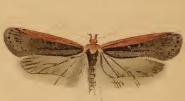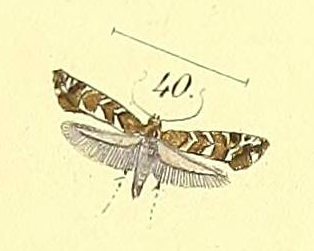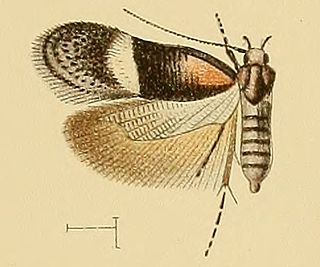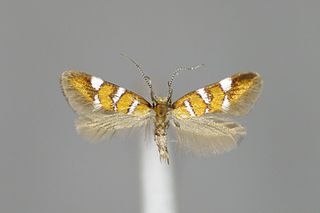Scrobipalpula is a genus of moths in the family Gelechiidae.

Argyresthia pygmaeella is a moth of the family Yponomeutidae. The species was first described by Michael Denis and Ignaz Schiffermüller in 1775 from a specimen found near Vienna, Austria

Nomophila noctuella, the rush veneer, is a species of moth of the family Crambidae.

Glyphipterix simpliciella, the cocksfoot moth, is a species of moth of the family Glyphipterigidae.

Depressaria pimpinellae is a moth of the family Depressariidae. It is found in most of Europe, except Ireland, Portugal and most of the Balkan Peninsula.

Glyphipterix equitella is a moth of the family Glyphipterigidae. It is found from Fennoscandia to the Iberian Peninsula, Sardinia, Sicily and Crete and from Ireland to Romania.
Eccopisa is a genus of snout moths. It was described by Zeller in 1848. It contains the species E. effractella. It is found in most of Europe, except Fennoscandia, Ireland and Estonia.
Mecyna trinalis is a species of moth in the family Crambidae. It is found in France, Spain, Italy, Austria, the Czech Republic, Slovakia, Poland, Hungary, the Balkan Peninsula, Ukraine, Russia, Turkey and North Africa, including Algeria and Morocco.
Glyphipterix argyroguttella is a moth of the family Glyphipterigidae. It is found in France, Italy and Russia.

Glyphipterix bergstraesserella is a moth of the family Glyphipterigidae. It is found in most of Europe, except Ireland, Great Britain, the Netherlands, Portugal, most of the Balkan Peninsula and Ukraine.
Glyphipterix diaphora is a moth of the family Glyphipterigidae. It is found on the Azores and Madeira.

Glyphipterix forsterella is a moth of the family Glyphipterigidae. It is found from most of Europe, east to Japan.

Glyphipterix fortunatella is a moth of the family Glyphipterigidae. It is found on the Canary Islands.
Glyphipterix gianelliella is a moth of the family Glyphipterigidae. It is found in France, Spain, Switzerland, Austria, Italy and the Caucasus.
Glyphipterix nicaeella is a moth of the family Glyphipterigidae. It is found in France and Switzerland.

Glyphipterix is a genus of sedge moths. It was described by Jacob Hübner in 1825.

Glyphipterix tungella is a species of sedge moth in the genus Glyphipterix. It is endemic to New Zealand.

Syncopacma genistae is a moth of the family Gelechiidae. It is found on the Canary Islands.

Psoricoptera gibbosella, the humped crest, is a moth of the family Gelechiidae. It is widely distributed in Europe. Outside of Europe, it is found in Turkey, North Africa, China, Japan, Korea, Siberia and the Russian Far East. The habitat consists of mature woodlands.

Fabiola pokornyi is a moth of the family Oecophoridae. It is found in the Czech Republic, Slovakia, Albania, Bulgaria, Hungary, Romania, North Macedonia, Greece and Ukraine. It is also present in Russia and the Near East.











